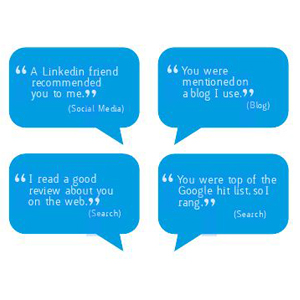
6 Critical Steps to Build Revenue From Inbound Marketing – Part 3
 Inbound Marketing – winning receptive customers and influencing the right people
Inbound Marketing – winning receptive customers and influencing the right people
We have probably all experienced the following Inbound Marketing opportunities, which happen billions of times a day around the world:
“A Linkedin friend recommended you to me.” (Social Media)
“You were mentioned on a blog I use.” (Blog)
“I read a good review about you on the web.” (Search)
“You were top of the google hit list, so I rang.” (Search)
Attracting people to you on their terms, when they are receptive and ready to engage is the strength of inbound marketing. Whilst outbound marketing is all about focusing on finding customers inbound marketing is focusing on new customers finding you. This reversal of logic and strategic direction is made possible through the web and the array of digital tools available today such as Search Engine Optimization (SEO), blogs, social media such as Facebook, Linkedin, Twitter etc. These tools enable us to find what we want, chat with the people we want to chat with and research information before purchasing something in real time from anywhere in the world. They are also there to help you get found by the right people at the right time.
Inbound Marketing is more effective because it is consent or permission based. In other words people choose to link or network with you on Linkedin/Facebook, follow you on twitter etc they are opting in to receive information, but of course they can also opt out so keeping the interest is key. Inbound Marketing is also targeted since people who come to your site have elected to do so and so you have a more qualified prospect. It is also a digitalised WOM, since you get recommended, and as we know WOM is the strongest form of marketing. The effectiveness also is expressed in zero or low direct costs since most of what you need is free, apart from your time of course. Finally the viral nature of Inbound Marketing means your name spreads as people show interest in your brand or products, which is further spread through social networks.
STEP 3 – GAIN BUY-IN FROM THE PEOPLE THAT COUNT
Inbound Marketing offers a new and exciting way of marketing that has low direct costs combined with more qualified leads. It is helping to automate the marketing process and putting buyers in front of you 60% cheaper than using the traditional outbound methods. It sounds perfect, and is if you implement and support it properly.
Implementation means you need to begin with a project to establish your Inbound Marketing plan and gain the support from the people that are going to provide the content for you inbound marketing. No Inbound Marketing strategy or plan can survive without the goodwill and effort of both internal and external stakeholders. Those stakeholders can include senior management, sales teams, marketing teams, customers and partners.
As with any project it is important to establish and allocate roles and responsibilities that cover who does what and when. This means you will be looking for internal sponsors that can help you manage the content of your inbound marketing. For example if you set up a blog or several blogs you will need people inside your organisation to contribute to the blog regularly, which can include your Managing Director. Alternatively you may need your marketing team’s help in SEO and analysing your web traffic or your sales team following leads generated and supplying customer stories and case studies.
Externally it is also a good idea to discuss your implementation project with customers and partners who can provide you with content support and even revenue support. You may want customer support in publishing articles and case studies and partner support in networking and even sponsoring web banners. Your partners and customers could even sponsor link to your site helping to drive further traffic, and raising your profile. Focusing on getting more links will help you to come up the search engine rankings since they use this as a measure of importance for a site.
Since the level of contribution is quite spread to SEO, social media and blogs it is important that whatever system you set up there is accountability built in. For example if someone comments on your company on Linkedin, Facebook or Twitter you need to be able to monitor the comments and conversations and reply as is necessary. This requires some discipline to monitor and follow up so there must be accountability and reporting built in so that you have an effective way of managing each element of your Inbound Marketing activities.
Stay tuned for Part 4…
Learn more about the six key steps you need to take to build your revenue with inbound marketing.
{{cta(‘b9e068e0-244e-43c4-a7eb-08721f948bdf’)}}
{{cta(‘4e346d8f-9758-4269-bc09-948259ae7e10’)}}
Read also: 6 Critical Steps to Build Revenue From Inbound Marketing – Part 1
Read also: 6 Critical Steps to Build Revenue From Inbound Marketing – Part 2
Read the latest positioning trends and insights.
Tap into our brand and product positioning, storytelling, and creative expertise to inspire your next strategic move.
 Inbound Marketing – winning receptive customers and influencing the right people
Inbound Marketing – winning receptive customers and influencing the right people
